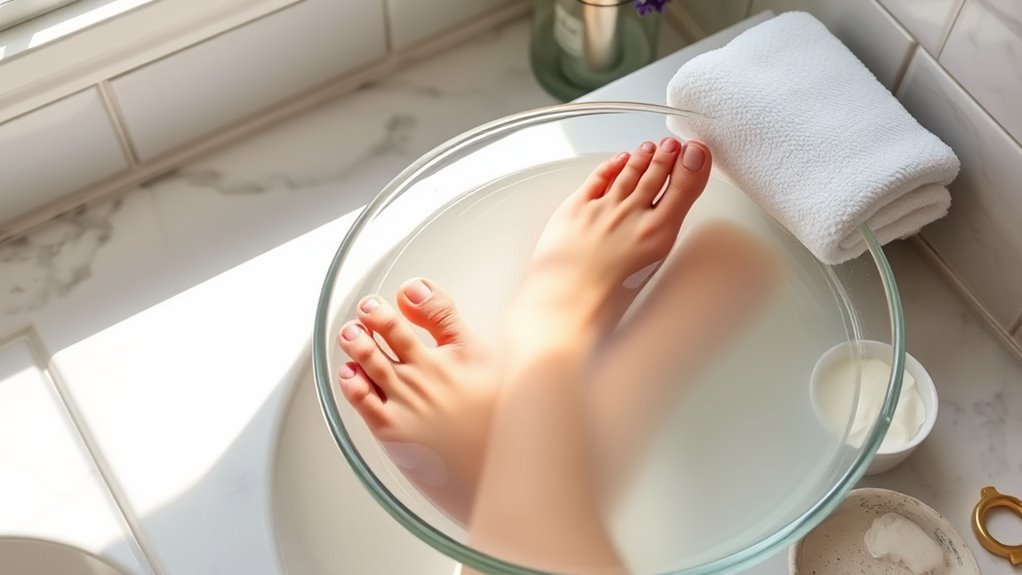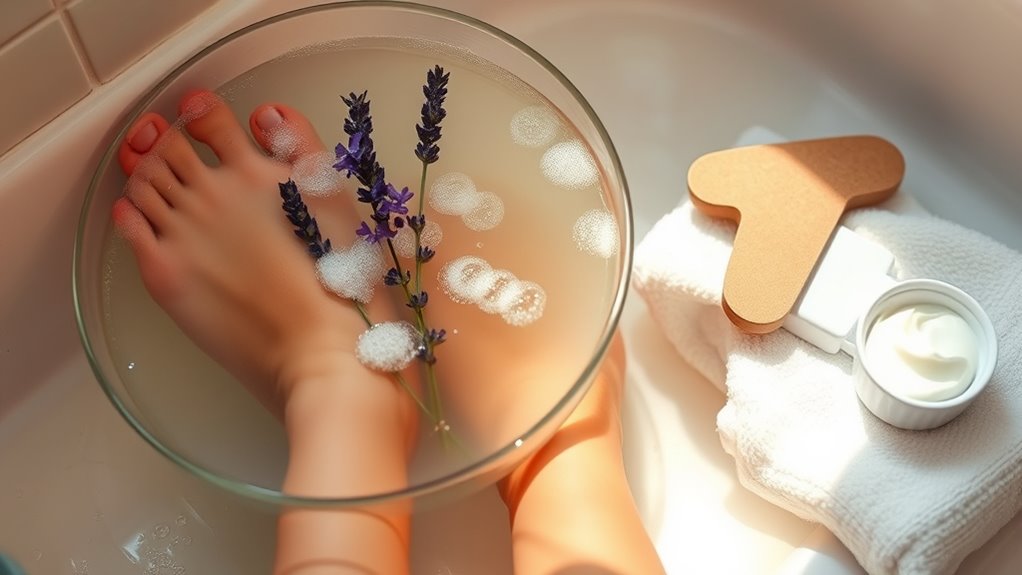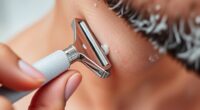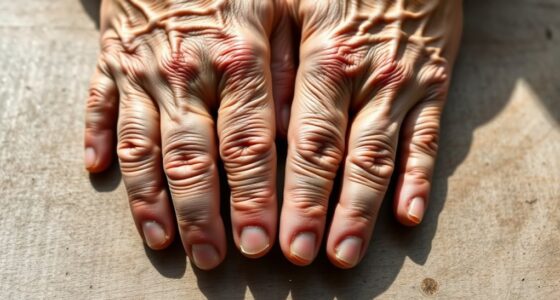To care for your feet at home, start with a warm, safe foot soak using Epsom salts and soothing essential oils like lavender. This softens thickened skin and relaxes muscles. Gently file calluses with a pumice stone, then moisturize with rich creams containing shea butter or glycerin. Wearing cotton socks after application helps lock in moisture. Staying consistent with these simple steps will keep your feet healthy and comfortable—stick around to learn more tips for excellent foot care.
Key Takeaways
- Soak feet in warm water with Epsom salts and essential oils for 10-15 minutes to soften skin safely.
- Gently use a pumice stone or foot file in circular motions to remove calluses without causing injury.
- Dry feet thoroughly and apply a rich moisturizer containing shea butter, glycerin, or urea for hydration.
- Wear comfortable, properly fitting shoes and cotton socks to prevent callus formation and maintain foot health.
- Incorporate routine foot care, including soaking, filing, and moisturizing, to keep feet soft and prevent rough patches.

Have you ever wondered how to keep your feet healthy without visiting a salon or clinic? The good news is, you can achieve soft, smooth, and well-maintained feet right at home with simple, safe practices. One of the most effective ways to start is by incorporating regular foot soaks. A warm soak helps relax your muscles, softens thickened skin, and prepares your feet for further care. To make a soothing foot bath, fill a basin with warm water—think comfortably warm, not hot—and add natural ingredients like Epsom salts, which help reduce inflammation and soothe tired feet. You can also toss in a few drops of essential oils such as lavender or tea tree for added relaxation and antimicrobial benefits. Soaking for about 10 to 15 minutes is enough to loosen dead skin and soften calluses, making them easier to manage afterward.
Once your feet are soaked and tender, you’re ready to address calluses and rough patches. Calluses develop as a protective response to repeated friction or pressure, but they can become thick and uncomfortable over time. To safely reduce them, gently rub a pumice stone or foot file over the affected areas, using light, circular motions. Be cautious not to remove too much skin at once, as over-aggressive filing can cause irritation or open wounds. Afterward, rinse your feet and dry thoroughly. Applying a rich moisturizer or foot cream—preferably containing ingredients like urea, shea butter, or glycerin—locks in moisture and keeps your skin soft. For extra hydration, wear cotton socks after moisturizing to help the lotion penetrate deeply and protect your skin throughout the day. Additionally, regular foot care routines can promote overall foot health and prevent common issues like calluses and dryness.
Preventing calluses from forming again is just as important as removing existing ones. Make sure your shoes fit properly, avoiding excessive tightness or rubbing. Regularly moisturizing your feet helps maintain their suppleness, reducing the likelihood of thickened skin. If you notice persistent or painful calluses, don’t try to cut or shave them yourself; instead, consult a healthcare professional. Remember, maintaining foot health is about consistency—integrate these simple routines into your weekly schedule for the best results. By dedicating a little time to foot care at home, you can keep your feet comfortable, healthy, and ready for any activity. With patience and gentle care, those rough patches and tired feet will become a thing of the past, all without the need for frequent salon visits.
Frequently Asked Questions
Can I Use Essential Oils in My Foot Soak?
Yes, you can use essential oils in your foot soak, but do so carefully. Add a few drops of pure essential oil, like tea tree or lavender, to warm water. Make sure to dilute it well to avoid skin irritation. Always do a patch test first, and avoid oils if you have sensitive skin or allergies. Using them properly can give your soak a soothing, aromatic boost.
How Often Should I Trim My Toenails?
Like trimming a garden to keep it thriving, you should trim your toenails every 4 to 6 weeks. This schedule prevents ingrown nails and maintains foot health. Avoid cutting too short or tearing the edges, as this can cause pain or infection. Regular trims keep your feet looking neat and healthy, much like tending to a well-maintained landscape. Stay consistent, and your feet will thank you.
Are There Specific Ingredients to Avoid in Foot Soaks?
You should avoid foot soaks with harsh ingredients like artificial fragrances, dyes, and strong chemicals such as acetone or alcohol, as they can irritate your skin. Stay away from high concentrations of essential oils unless diluted properly, especially if you have sensitive skin. Also, avoid soaking in very hot water for long periods, which can strip moisture and cause dryness or burns. Opt for gentle, soothing ingredients like oatmeal or Epsom salts instead.
What Signs Indicate a Foot Infection?
You should watch for signs like increased redness, swelling, warmth, or tenderness around your foot. If you notice pus, foul odor, or if a sore isn’t healing or gets worse, these could indicate an infection. You might also experience fever or chills if the infection is severe. If any of these signs appear, it is crucial to see a healthcare professional promptly to prevent complications.
Is It Safe to Use a Pumice Stone Daily?
Using a pumice stone daily is like walking a tightrope—too much can cause harm. It’s generally safe if your skin isn’t sensitive or cracked, but overusing can lead to irritation or even small cuts, risking infection. Instead, limit use to 2-3 times a week, and always soak your feet beforehand to soften calluses. Listen to your skin’s signals and stop if you notice redness or discomfort.
Conclusion
Taking care of your feet at home is simple and effective. Regular soaks and understanding callus basics can prevent discomfort and infections. Did you know that over 70% of foot problems can be avoided with proper self-care? By dedicating a few minutes each week, you can keep your feet healthy, comfortable, and pain-free. Stay consistent, listen to your body’s signals, and enjoy the confidence that comes with well-maintained feet.









